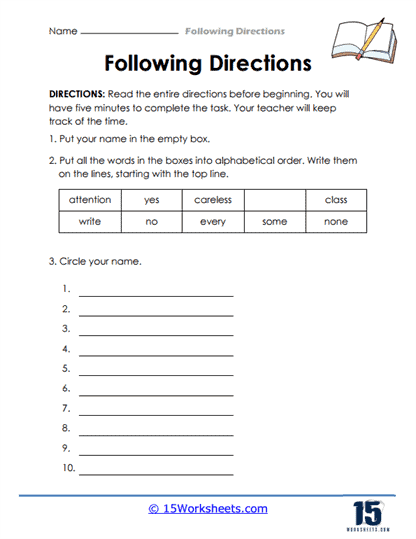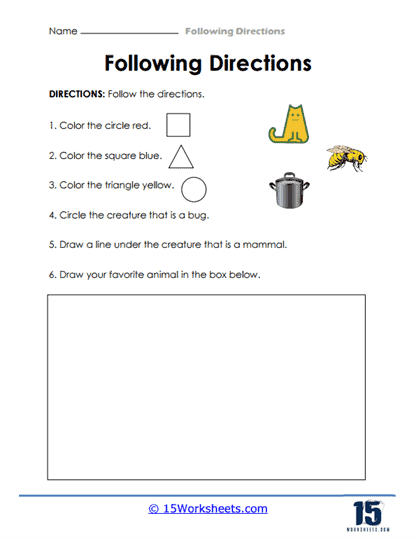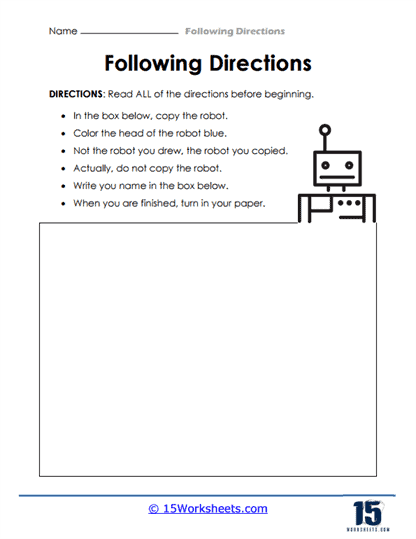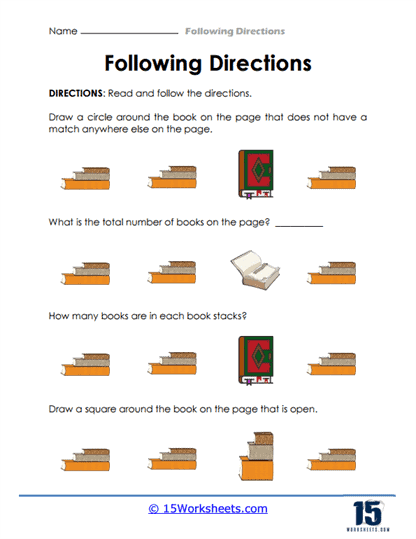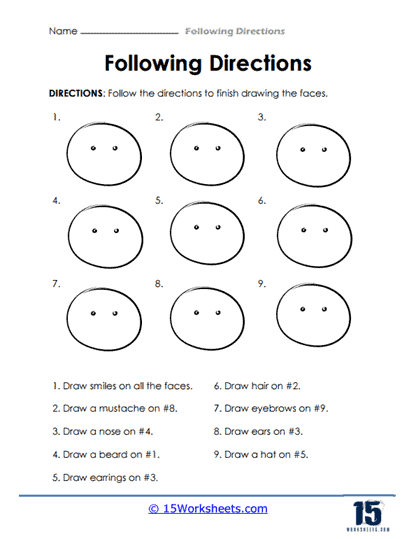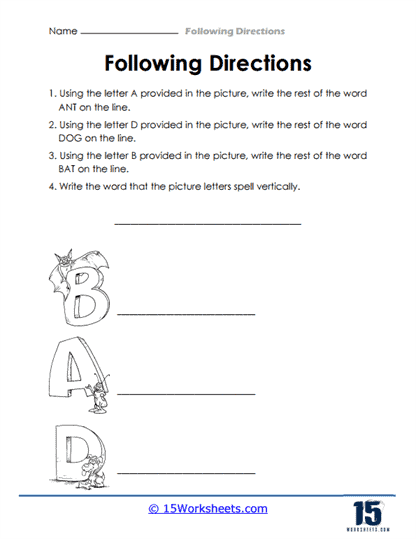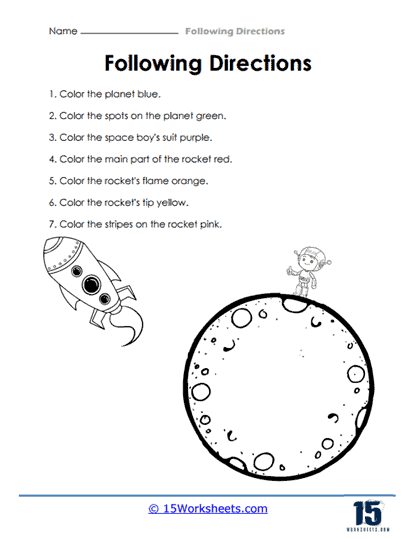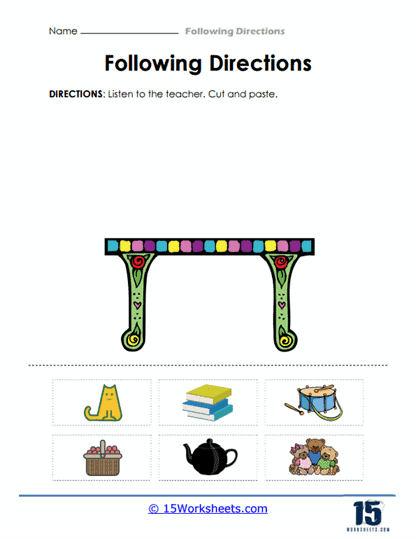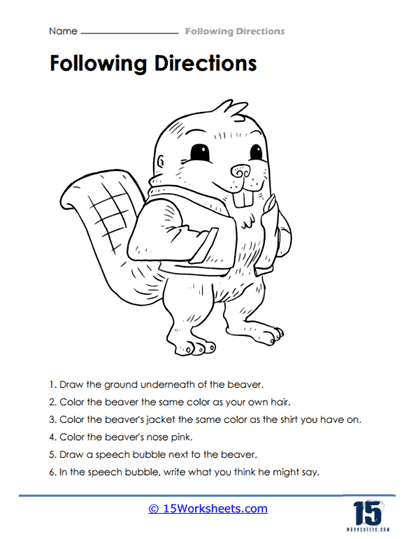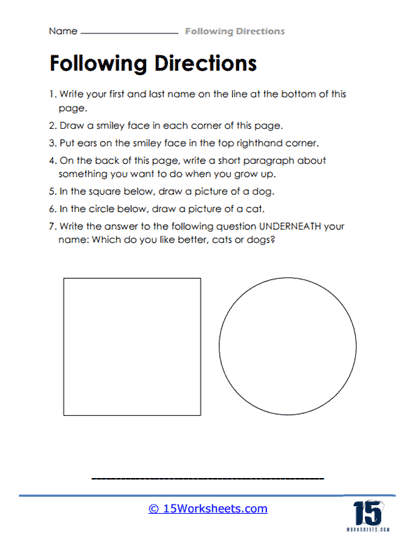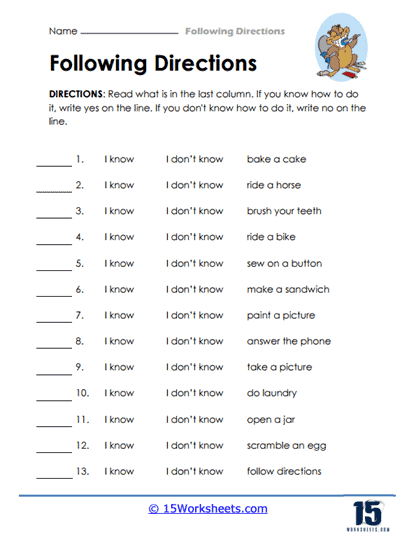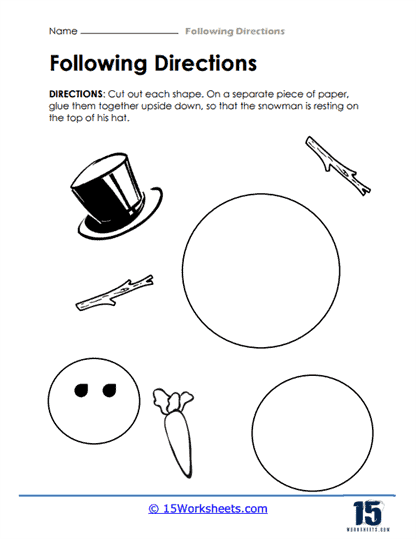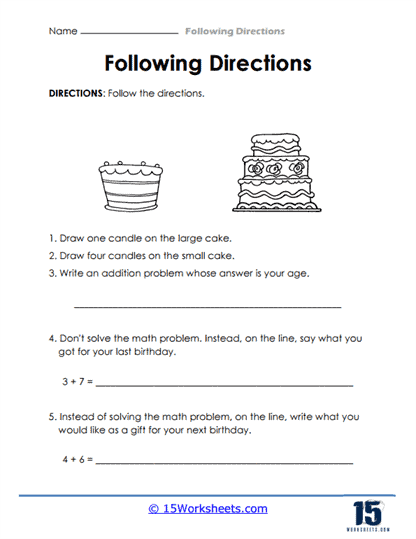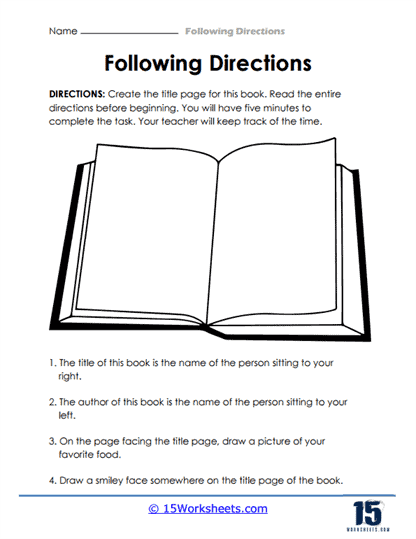Following Directions Worksheets
All About These 15 Worksheets
This collection of worksheets emphasizes the importance of paying attention to detailed instructions to successfully complete various tasks. The exercises vary in complexity, targeting different aspects of following both visual and written instructions. These worksheets engage students by using tasks that involve recognizing shapes, organizing words, coloring images, and solving problems based on directions provided. Each task requires students to carefully read or observe before taking action, thereby reinforcing the significance of processing instructions before completing them.
The diversity in task formats supports the development of different skills, such as alphabetical ordering, shape recognition, motor coordination, and literacy. The worksheets also stimulate logical thinking by including tasks that require students to circle, color, or identify objects that match specific criteria. Additionally, some exercises involve decision-making based on the understanding of the instructions, making students reflect on the steps they need to follow before acting. These activities serve to improve focus and promote critical thinking skills as students need to be both accurate and timely in their responses.
The collection effectively encourages students to practice a range of cognitive and fine motor skills, all under the umbrella of following directions. By offering varied and interactive content, these worksheets cater to multiple learning styles, combining fun activities with educational outcomes. They are suitable for reinforcing important foundational skills in a classroom or home learning environment, making them an effective tool for teachers and parents alike.
Imagine a child sitting in a classroom, eyes wide with curiosity as they are handed a new worksheet, eager to see what challenge awaits them today. At first glance, it may seem like just another exercise-perhaps a sheet of paper filled with boxes and circles, or a set of blank spaces waiting to be filled. But in reality, this simple worksheet holds something far more powerful. It is an introduction to one of the most essential skills they will ever need: the ability to follow directions.
At their core, these worksheets will help students practice a multitude of vital skills, from listening and reading comprehension to the ability to carry out specific tasks. They are deceptively simple. A task like “Color the circle red,” or “Draw a square around the star,” may seem straightforward, but beneath the surface, these activities engage a child’s cognitive abilities in critical ways.
Think for a moment about what happens when a student receives an instruction. They must first listen or read carefully, interpret the meaning, and then decide how to execute the action. It may sound easy, but consider how much focus and understanding are required. A missed word or misunderstood phrase can completely change the outcome. These worksheets are not just about coloring or drawing—they are about training the brain to listen attentively, read for detail, and execute tasks with precision. In essence, they help students build the foundation for more complex thinking and learning.
As students progress through different grade levels, the complexity of these worksheets increases. Younger children start with basic tasks like identifying colors, shapes, or numbers. For example, a worksheet for a first grader might ask them to color all the circles in a row red and all the squares blue. Though simple, these exercises test their ability to distinguish shapes and recognize colors, sharpening both their visual processing and fine motor skills. For older students, these tasks evolve into multi-step challenges that demand more advanced cognitive functions. Consider an instruction such as “Fold the paper in half, draw two circles on the left side, and write your name inside the right circle.” Here, students must not only follow each step carefully but also sequence their actions, visualize the end result, and ensure that their final product adheres to the original instructions.
Attention to Detail
As much as these worksheets help with practical skills, they also encourage critical thinking. Children quickly learn that there is a reason for each instruction, that a missing step or incorrect execution can lead to an outcome very different from what was intended. In this sense, following directions becomes a way of thinking logically and methodically. The student is prompted to ask questions like, “Why should the circle be red?” or “What happens if I color the square green instead of blue?” They are actively engaging with the material, testing hypotheses in real-time, and drawing conclusions based on the outcome. This is the essence of problem-solving.
For older students, these activities take on even greater significance. Multi-step tasks help them develop the ability to plan and organize. A worksheet might ask a high school student to complete a geometry problem, follow a set of lab instructions in chemistry, or even organize a mock debate. These exercises require careful attention to sequencing, prioritization of tasks, and the ability to follow through to completion-all skills that are critical for success in higher education and future careers.
While these worksheets are normally used within a school setting, the skills they teach have far-reaching implications beyond the classroom. The ability to follow directions isn’t just an academic skill—it’s a life skill. Consider a child who has mastered these worksheets. That same child is now more likely to succeed in situations where following instructions is key. They will understand how to break down complex instructions into manageable steps, whether it’s for building a Lego structure, completing a science project, or tackling a set of directions in a video game.
This skill becomes even more important as students transition into adulthood. Following directions accurately can influence success in nearly every aspect of life-from personal relationships to professional settings. In a workplace, for instance, the ability to follow precise instructions can mean the difference between successfully completing a project or making costly errors. Imagine a surgeon in an operating room, or a mechanic working on a car engine-both professionals rely on their capacity to follow instructions with precision. Similarly, in many careers, being able to understand and execute multi-step procedures efficiently directly impacts performance, safety, and productivity.
These worksheets teach students something far more intangible but equally important: discipline and patience. Following directions requires an individual to pause, to think before they act, and to resist the temptation to rush through a task. For younger children, this can be a significant hurdle. They may want to dive straight into drawing, coloring, or writing without fully absorbing the instructions. Through repeated practice, however, students learn that slowing down and paying close attention leads to success. This practice of mindfulness-of being fully present in a task-translates into better focus, more thoughtful decision-making, and ultimately greater success in both school and life.
In a world where instant gratification is increasingly the norm, the discipline fostered by these worksheets is a crucial life lesson. They teach children to engage with the process, to enjoy the challenge of carefully following steps, and to recognize the value in doing a task well. Whether they are assembling a complicated toy or tackling an assignment, this skill of “staying with it” becomes vital.
How To Teach Students to Follow Directions?
Teaching students to follow directions is an essential skill that contributes to their academic success and personal development. Here are some strategies to help teach students to follow directions effectively:
Be clear and concise: When giving directions, use clear, simple, and concise language to ensure students understand the task at hand. Avoid using jargon, and break down complex instructions into smaller, manageable steps.
Model the behavior: Demonstrate the process of following directions by modeling the behavior you expect from your students. Walk them through the steps, and provide examples to show the correct way to complete a task.
Use visual aids: Incorporate visual aids, such as charts, diagrams, or written instructions, to help students better understand and remember the directions. Visual aids can be particularly helpful for visual learners.
Repeat instructions: After giving directions, repeat them to reinforce understanding and ensure that all students are on the same page. Encourage students to repeat the directions back to you or to a partner to further solidify their understanding.
Check for understanding: Regularly check for understanding by asking students to explain the directions or the task in their own words. This will help identify any confusion or misunderstandings that need to be addressed.
Provide opportunities for practice: Offer students plenty of opportunities to practice following directions through various activities, exercises, or assignments. The more practice they have, the more comfortable and proficient they will become in following directions.
Use positive reinforcement: Praise and acknowledge students when they successfully follow directions, as this can boost their confidence and motivation to continue practicing this skill.
Encourage active listening: Teach students the importance of active listening by maintaining eye contact, avoiding distractions, and focusing on the speaker when directions are being given.
Create a supportive environment: Establish a classroom environment that encourages open communication, questions, and clarification. Ensure students feel comfortable asking for help or requesting further explanation if they are unsure about the directions.
Be patient and consistent: Learning to follow directions takes time and practice. Be patient with students as they develop this skill, and consistently reinforce the importance of following directions in various situations.
By incorporating these strategies into your teaching, you can help students develop the essential skill of following directions, which will not only benefit their academic performance but also their personal growth and future success.
Why Is Following Directions Important?
Understanding and following directions is an important skill for several reasons, as it has implications for academic performance, personal growth, and future success in various aspects of life:
Academic success: Following directions is crucial for completing assignments, projects, and exams correctly. Students who can accurately follow directions are more likely to achieve better grades, understand complex concepts, and develop strong problem-solving skills.
Developing good listening skills: Following directions requires active listening, which is an essential communication skill. Active listening involves focusing on the speaker, understanding the message, and responding appropriately. Developing good listening skills can lead to better comprehension and collaboration in academic and professional settings.
Time management: Being able to follow directions effectively helps students manage their time more efficiently. When students understand and follow directions correctly, they can complete tasks in a timely manner, reducing the need for corrections or additional guidance.
Personal growth: Following directions fosters self-discipline, responsibility, and independence in students. These qualities are valuable for personal growth and contribute to the development of a strong work ethic and sense of accountability.
Workplace readiness: In professional settings, the ability to follow directions is essential for meeting job expectations, adhering to safety protocols, and working effectively as part of a team. Employees who can accurately follow directions are more likely to be successful, productive, and valuable members of their organization.
Daily life: Following directions is a vital skill in everyday life, as it helps individuals navigate various situations, such as driving, cooking, assembling furniture, or using technology. Being able to follow directions accurately and efficiently can save time, prevent accidents, and ensure successful completion of tasks.
By teaching students the importance of following directions and providing them with opportunities to develop this skill, educators can set them up for success in their academic, personal, and professional lives.

